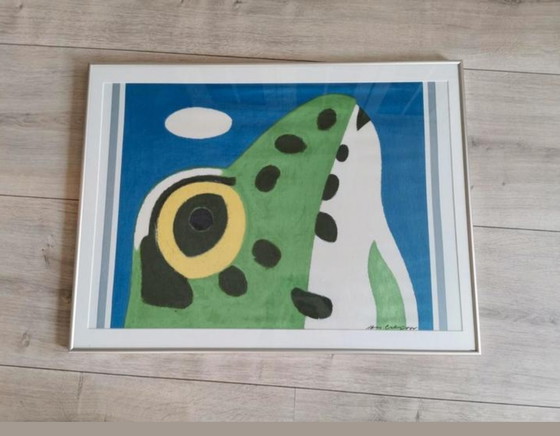Have it delivered hassle-freeBuyer protectionAll Designer items curated by WhoppahDownload the Whoppah App – get alerts & sell with ease.

Jan Gregor- Frog screen print on cotton silk
€450€250-44%Bid from €195
Buy with confidence
Shop & pay safely with our Buyer ProtectionDesigner items curated by WhoppahWe only pay the seller once you have safely received the itemTrusted payment methods
About this seller
Product description
Texoprint bv annually asked an artist to produce a screen print on textile, which was released in a limited edition.
Title: Frog
Year: 1994
Fabric dimensions: 92 cm x 89 cm
Edition: Limited (edition number unknown)
Signed: Yes, in print
Material: Screen printing on cotton silk
Jan Gregor was a Dutch painter and draftsman. He trained as a lithographic draftsman with Lithography Lankhout en Mortelmans (1928-1930) and an evening course at the Royal Academy of Art in The Hague (1930-1934). During the Second World War he put his artistic talents at the service of the resistance by forging stamps and identity documents, sometimes assisted by Max Velthuijs.
After the war, from 1946 to 1958, he lived in Cuijk. There, together with Wim Noordhoek, Enno Brokke and Ap Sok, he was part of the core of the Cuijkse Groep, a group of artists whose source of inspiration was the Land van Cuijk. In 1958 he made study trips to France and Spain. In 1958 he moved to Eindhoven, where he started teaching at the Eindhoven Academy of Industrial Design, where he counted Helen Berman, Els Coppens-van de Rijt, Jan Dibbets and Jan van Gemert among his students. He was a brother of critic and essayist Nol Gregor.
Jan Gregor was both a painter and draftsman; he also worked as a lithographer (1929-1938) and cartographic draftsman (1938-1945). The materials he used were chalk and wax crayon in 1947-1958; then oil paint, gouaches in expressionist style (ca. 1966), chalk and pen drawings, mosaics (Westerbeek school). He has made many still lifes that sometimes seem a bit surreal, as well as portraits, landscapes (around Nijmegen) and city views (including Paris). After 1965 his style changes markedly; the subdued colors give way to light, bright colors, and around 1968 his style is called abstract.
Since 1953 his work has been regularly exhibited in galleries and museums, including the Van Abbemuseum in Eindhoven, the Stedelijk Museum in Amsterdam and the Boymans van Beuningen Museum in Rotterdam.
Specifications
ConditionVery goodNumber of items1First ownerYesHeight92 cmWidth89 cm
Discover more
Seller information
About this seller
Den Haag, NetherlandsOn Whoppah since May 2022 • 0 sales



